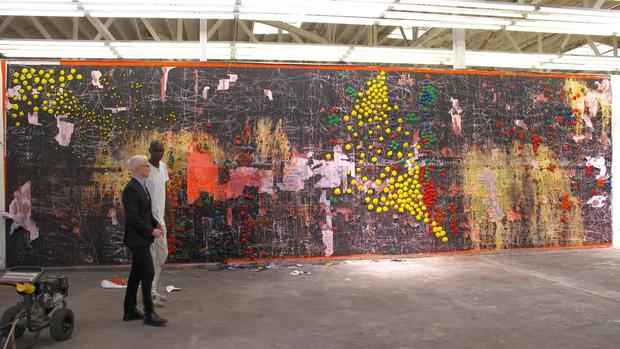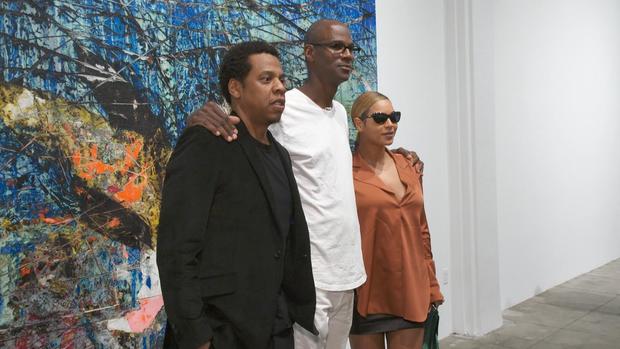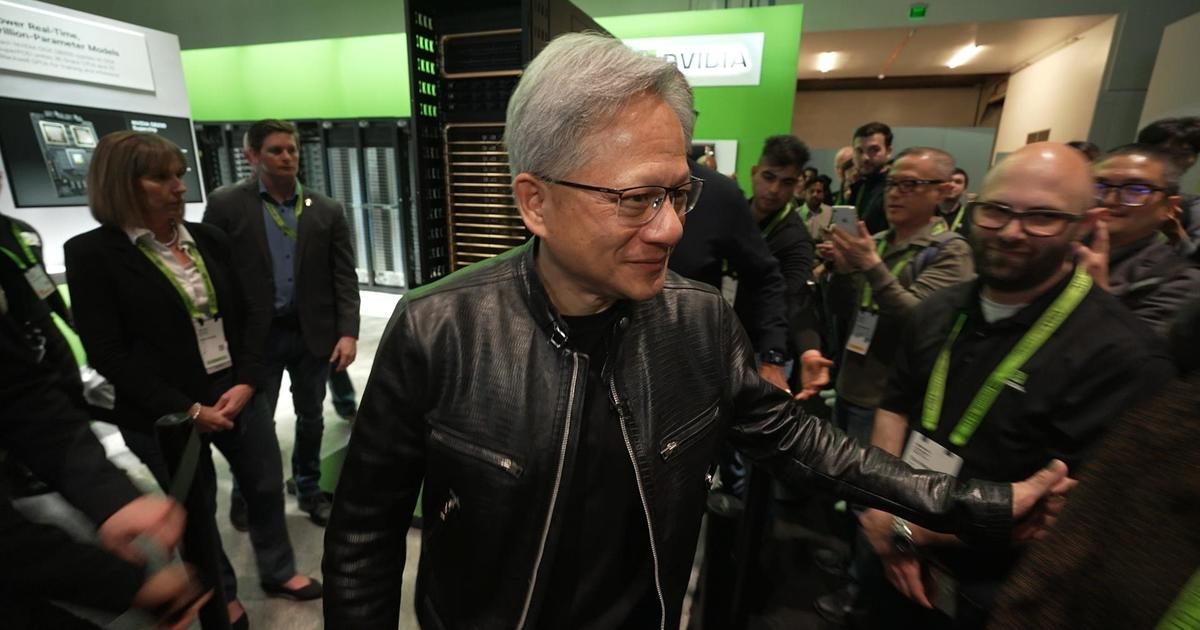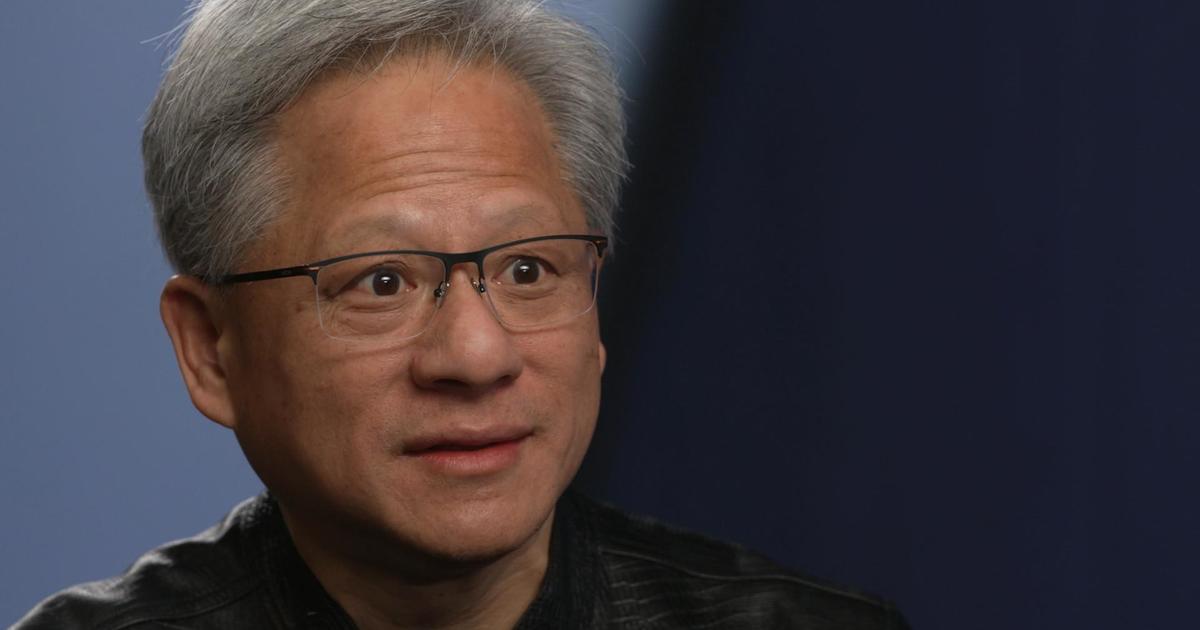Mark Bradford: The 60 Minutes Interview
Mark Bradford is widely considered one of the most important and influential artists in America today. As we first reported this spring, his abstract canvases, which often deal with complex social and political issues, hang in major museums around the world, and on the walls of big collectors and some small ones, like Anderson Cooper. Bradford's art may look like paintings, but there's hardly any paint on them. They're made out of layers and layers of paper, which he tears, glues, power washes and sands in a style all his own. When he began making art in his 30's, Bradford couldn't afford expensive paint, so he started experimenting with endpapers, that are used for styling hair. He got the idea while working as a hair stylist in his mom's beauty shop in South Los Angeles. He was broke, struggling, and didn't sell his first painting until he was nearly 40.
Anderson Cooper: I heard a story that when you sold your first artwork in 2001 you called up your mom. Do you remember what you said to her?
Mark Bradford: I said, "Girl, I think I found a way out of the beauty shop. (LAUGHTER) Girl, I think I found a way outta the beauty shop." Yeah. Yeah, because I had no idea how I was gonna stop being a hairstylist, because that's really the only thing that I knew. I didn't have a problem with being a hairstylist, but it's all I knew.
Anderson Cooper: It's incredible to think that 2001 is when you first sold a work, and now—
Mark Bradford: I still sell works.
Anderson Cooper: Yeah, you sure do. (LAUGH)
Mark Bradford: I sure do.
His first painting sold for $5,000. Now they can sell for more than $10 million. This new one was bought by the Broad Museum in Los Angeles. They have nine other Bradford's in their collection.
It's called "Deep Blue." It's 12 feet high, 50 feet long, and took a full day to install.
None of those colors you see are paint, it's all paper layered on canvas. It's abstract, but not entirely. See those lines that form a grid? It's a street map of the Watts neighborhood in Los Angeles. The colored balls show where properties were damaged in 1965 after six days of violent civil unrest, protests over police brutality and racial inequality.
We first saw the painting nearly a year ago, when Bradford had just started working on it in his studio in South Los Angeles.
He'd already made the map of Watts out of bathroom caulking.
The following month when we stopped by again, he'd laid down fourteen layers of colored paper, and covered it all up with a layer of black.
Anderson Cooper: So there's a map underneath here?
Mark Bradford: Yes.
Anderson Cooper: Of Watts?
Mark Bradford: Uh-huh (AFFIRM). All these little points are what was looted, what was destroyed. So I kinda start from a map, and then on top of it-- I think I lay art history and my imagination. All three.
Bradford uses household tools to make his paintings. He likes to buy everything at Home Depot.
Mark Bradford: My motto was, "If Home Depot didn't have it, Mark Bradford didn't use it." And--
Anderson Cooper: (LAUGH) That's-- that's your-- that's your motto--
Mark Bradford: That's my motto. That was my motto--
Anderson Cooper: To this day, is that--
Mark Bradford: To this-- to this day
Building up the layers of paper on the canvas, is just the beginning of his process, he then starts to peel, cut and sand them down – which can take months.
Anderson Cooper: It's like an archeological dig.
Mark Bradford: It is like an archeological dig. It's like history. I'm creating my own archaeological or psychiol-- psychological digs. Sometimes when I'm digging on my own painting I'm asking myself, "Well, exactly what are you digging for? Where do you want to go child?
Anderson Cooper: A lot of people look at a abstract painting and think, "It's squiggles, it's torn paper. I don't understand it."
Mark Bradford: Yeah, that's true. But for me-- those squiggles and torn paper gives me a space to kind of unpack things. Like the Watts riots. I'm grappling with how I feel about that subject and that material. I do grapple with things. I gr-- grapple with things personally, and you know, racially, and politically. What does it mean to be me?
Mark bradford has been grappling with that question in his art for the last 18 years. From making paintings out of street posters, like those offering predatory loans in low-income neighborhoods, to creating works that address HIV/AIDS, racism and the complexity of American history.
He's 57 years old now and at 6'8", stands out in a crowd. He still lives in South Los Angeles, where he grew up. When he was eight he says he began to get bullied by neighborhood kids.
Mark Bradford: That was the first time I felt different. That was the first time I was aware of my sensitivity. That's the first time someone said, "Oh, you're-- you-- you-- you're a sissy." I definitely knew that I had to learn to navigate in a more cautious way. So that I could survive. I just never had a problem being me.
Anderson Cooper: So even though people they were calling you sissy, it didn't make you want to try to change yourself?
Mark Bradford: Not really, No not really. I just didn't want to get my ass whooped.
He was raised by his mother, Janice Banks, who owned her own beauty salon. That's where Bradford would head everyday after school.
Mark Bradford: I knew that I had to find a way to get across the schoolyard. I knew that my mother was always going to be there once I got across the schoolyard. And maybe-- maybe, I was in the hair salon every day watchin' women get across the schoolyard (LAUGHS) I would hear their stories. I would watch them go through-- and I just thought, "If they can do it, I most certainly can do it."
Mark Bradford started working in the salon as a teenager, eventually becoming a hairstylist. It was a safe place where he could be himself but that feeling disappeared in 1981, when his friends began dying from AIDS.
Mark Bradford: I knew a storm was coming. I knew that in the gut. I knew that. And people were just dying. That's what it felt like to me at 18 years old. I just was thinking, "How are we going to make it through?"
Anderson Cooper: Did you think you would make it through?
Mark Bradford: No. No. I didn't think I'd make it through.
Thinking he didn't have a future, he didn't plan for one. But when he was nearly 30 he took art classes at a junior college and he says it clicked.
Mark Bradford: it was the reading and learning about different scholars and feminism and deconstructing modernism and all-- I just-- oh, man, this is-- I'm really into this. I'm not exactly sure what it is, but I'm-- it just-- yeah.
Anderson Cooper: And you'd still work at the hair salon?
Mark Bradford: Oh, yeah every day.
Anderson Cooper: And so you'd be studying while at the hair salon?
Mark Bradford: Oh, absolutely. They-- I put the book in their lap and said, "Girl, read that back to me."
He won a scholarship to the California Institute of the Arts, but struggled to make money as an artist. When he was 39 he finally had a breakthrough.
Mark Bradford: I was working on a head.
Anderson Cooper: Working on a head?
Mark Bradford: Working on a head, working on a--
Anderson Cooper: At the beauty salon.
Mark Bradford: --beauty salon, yeah. 'Cause I was still working the hair salon, Anderson, I told you that.
Anderson Cooper: I just didn't know that terminology.
Mark Bradford: I was hooking it up. Right, late at night. I was tired as hell, too. And-- just end papers fell on the floor. And I looked down, I thought, "Oh, they're translucent. Oh. Oh, I could use these."
Endpapers are small rectangular tissues used to make permanent waves in hair. Bradford began burning the papers' edges, and lining them up into grids he glued onto bed sheets.
Mark Bradford: I knew I was onto something. I knew this was-- bridging, This material came from a sight outside of the paint store. I think early on, I was trying to weave these two sides of who I was together, the art world and the sights that I had come from, the life that I had led, I didn't want to leave any of it be-- I didn't want to edit out anything.
Private collectors began snapping up his endpaper paintings, and his career took off.
He is now a celebrity in the art world, his gallery openings are star studded events.
At the latest one in Los Angeles, Beyoncé and Jay-Z, who own several Bradfords, stopped in. The 10 paintings in this exhibition sold out before the gallery doors opened.
Bradford and his partner of more than 20 years, Allan Dicastro, are committed to using contemporary art and their own money to revitalize the neighborhood Bradford grew up in. In 2014, they opened Art + Practice, with, Eileen Harris Norton, the first collector to buy Bradford's work. It's a nonprofit complex of buildings that includes a gallery, lecture spaces, and his mother's old beauty salon.
Mark Bradford: This is the last hair salon that my mom worked in, and then I took it over from her. It was in the '90s. It was called Foxy Hair.
They turned foxy hair into a center for young adults transitioning out of foster care.
But we were surprised to learn that Mark Bradford still styles hair. He does it for some of his former clients from the beauty shop who are also among his closest friends.
Anderson Cooper: When you look around, does his art make sense to you?
Cleo Jackson: I-- it does. It's like a map (LAUGHTER) in outer space--
Danielle Wright: No. I mean, I look at it, it's beautiful, but I don't really--
Lynette Powell: Get it.
Female Voices: Get it. Yeah.
Lynette Powell: He gave me-- something from his studio a long time ago. And I put it in my garage. (LAUGH)
Mark Bradford: She did.
Anderson Cooper: Wow.
Mark Bradford: And I told her--
Lynette Powell: And I put it in my garage.
Mark Bradford: I said, "Girl--"
Lynette Powell: This is before he got like—
Mark Bradford: Okay.
Lynette Powell: --popular, I guess. And, yeah, and it's-- and it's all torn up And this guy was like "You know, you have something like a Mona Lisa." I'm like, "For real?" (LAUGHTER)
Mark Bradford: Y'all wrong for that.
Lynette Powell: --I don't see it. I'm--
Anderson Cooper: You don't see it?
Lynette Powell: I don't, But I like how you give a little insight of, like, what's going on in our community. I know that much about your art. So that much I really like.
Bradford's latest work continues to focus on difficult and controversial issues. This painting, which is prominently displayed in the Los Angeles County Museum of Art, is called 150 Portrait Tone. And was made in response to the 2016 fatal police shooting of Philando Castile during a traffic stop in Minnesota.
Diamond Reynolds in livestream of shooting: He was trying to get out his ID in his wallet out his um, pocket...and he let the officer know...
Castile's girlfriend Diamond Reynolds livestreamed the incident, Bradford was so haunted by her words, he made them into this painting.
Diamond Reynolds in livestream of shooting: "Please don't tell me this Lord, please Jesus don't tell me that he's gone."
Anderson Cooper: It's really the conversation that -- his girlfriend is having.
Mark Bradford: With multiple people, which I was fascinated by.
Anderson Cooper: Why were you fascinated by it?
Mark Bradford: how composed she was. She was having a conversation with her daughter in the backseat, with Philando, who was passing away, with God, with us, Facebook, and with the policeman, all simultaneously. it was visual, and textual, and heartbreaking, and heroic, and strong all at the same time.
In another major new work, Bradford turned his gaze to the Civil War. It's called Pickett's Charge. And it's a reimagining of a pivotal Union victory at the Battle of Gettysburg. It was commissioned by the Smithsonian's Hirshhorn Museum in Washington, D.C.
Bradford used as his starting point blown up photos of a 19th century panoramic painting of Pickett's Charge, a painting which offers a romanticized view of the Confederacy. He then added layers of paper and cords over it, then carefully gouged, shredded and ripped it apart.
Mark Bradford: They almost feel like lacerations.
Anderson Cooper: Uh-huh (AFFIRM).
Mark Bradford: Almost scaring.
Anderson Cooper: Uh-huh (AFFIRM).
Mark Bradford: That's what those feel like. And a little bit like bullet wounds. Like you're really--
Anderson Cooper: Uh-huh (AFFIRM). Yeah.
Mark Bradford: --punctures.
It's a 360-degree painting that raises many questions in Bradford's mind particularly about how we look at history.
Anderson Cooper: It's looking at it through a different lens.
Mark Bradford: Yes, that's the feeling that I wanted you to have, that history was laying on top of it, that-- that-- gouging into it, erasing it-- bits of it showing. It's kind of me kind of revising it in a way.
Anderson Cooper: So is this a more accurate representation of history?
Mark Bradford: I don't really believe history's ever fully accurate.
Anderson Cooper: It's acknowledging that?
Mark Bradford: it's acknowledging the gaps, the things we don't know.
So many people have come to see Pickett's Charge; the Hirshhorn has extended the exhibition for three more years. Bradford recently opened a show in China and is working on new paintings for shows in London and New York.
Anderson Cooper: Do you worry about the vagaries of the art world. What is popular today, 20 years from now --
Mark Bradford: Oh no, no, no, no. I wouldn't have. No. I have never--
Anderson Cooper: I mean, art has value because people believe it has value.
Mark Bradford: I-- no, I think art has value because it has value. I'm not gonna wait for somebody else to tell me my work has value. I certainly wasn't gonna wait on people to tell me I had value. I'd probably still be waiting. I just-- it has value 'cause I think it has value. And then if other people get on the value-- you know, Mark Bradford value train, great.
Produced by Ruth Streeter and Kaylee Tully







